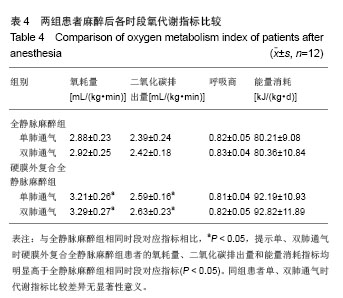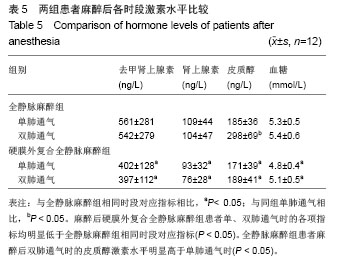中国组织工程研究 ›› 2014, Vol. 18 ›› Issue (27): 4304-4309.doi: 10.3969/j.issn.2095-4344.2014.27.008
• 细胞与组织移植 cell and tissue transplantation • 上一篇 下一篇
麻醉方式对序贯式双肺移植患者呼吸功能及肺功能的影响
黄乐林
- 解放军第171医院麻醉科,江西省九江市 332000
Effect of anesthetic methods on respiratory and lung functions of patients after sequential double lung transplantation
Huang Le-lin
- Department of Anesthesiology, the 171 Hospital of Chinese PLA, Jiujiang 332000, Jiangxi Province, China
摘要:
背景:在非体外循环的条件下,保证患者在麻醉效果良好的情况下完成序贯式双肺移植,胸段硬膜外复合全静脉麻醉和全静脉麻醉的选择上尚存在争议。 目的:观察序贯式双肺移植过程中两种不同的麻醉方式对患者呼吸功能及肺生物学功能的影响。 方法:将24例序贯式双肺移植患者分为全静脉麻醉组及硬膜外复合全静脉麻醉组。对两组患者麻醉后单、双肺通气10 min后的氧耗量、二氧化碳排出量、呼吸商和能量消耗进行测定。同时,对比分析两组患者移植过程中去甲肾上腺素、肾上腺素、皮质醇以及血糖水平参数变化。 结果与结论:两组患者在移植后6个月、1年及3年的随访调查中,肺功能均得到明显的改善,血气分析状况良好,两组差异无显著性意义。两组患者的并发症发生率、急性排斥反应及死亡率差异均无显著性意义(P > 0.05)。麻醉后硬膜外复合全静脉麻醉组单、双肺通气患者的氧耗量、二氧化碳排出量和能量消耗指标均明显高于全静脉麻醉组相同时段对应指标(P < 0.05)。同组患者单肺通气的氧耗量、二氧化碳排出量和呼吸商指标低于双肺通气,但差异不明显(P > 0.05)。硬膜外复合全静脉麻醉组单、双肺通气患者的去甲肾上腺素、肾上腺素、皮质醇以及血糖水平均明显低于全静脉麻醉组相同时段对应水平(P < 0.05)。全静脉麻醉组麻醉后双肺通气患者的皮质醇激素水平明显高于单肺通气患者(P < 0.05)。硬膜外复合全静脉麻醉组患者去甲肾上腺素、肾上腺素、皮质醇以及血糖水平在单、双肺通气时的差异不明显(P > 0.05)。提示在双肺移植过程中,胸段硬膜外复合全静脉麻醉与全静脉麻醉相比,患者氧耗量、二氧化碳排出量和能量代谢明显增强,可减轻应激反应,且麻醉后代谢、应激情况不受通气方式影响。
中图分类号:




